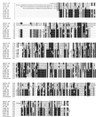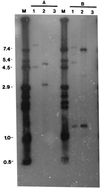An operon that confers UV resistance by evoking the SOS mutagenic response in streptococcal conjugative transposon Tn5252
- PMID: 10217768
- PMCID: PMC93719
- DOI: 10.1128/JB.181.9.2782-2788.1999
An operon that confers UV resistance by evoking the SOS mutagenic response in streptococcal conjugative transposon Tn5252
Abstract
Streptococcus pneumoniae Rx1 is capable of repairing lesions caused by DNA-damaging agents in an error-free manner but lacks a UV-inducible error-prone repair system due to the absence of chromosomally encoded UmuDC-like proteins. We have identified an operon-like structure 8 kb from the left end of the pneumococcal conjugative transposon Tn5252 that confers SOS function in the host cells. DNA sequence analysis of this region revealed the presence of four open reading frames (ORFs). The deduced amino acid sequence of one of them, ORF13, which is capable of encoding a protein of 49.7 kDa, showed significant homology to UmuC, MucB, and other proteins involved in the SOS response. The carboxy-terminal region of another, ORF14, which is predicted to encode a 26-kDa polypeptide, shared similarity with UmuD- and MucA-like proteins that carry the amino acid residues recognized by the activated RecA* protein for proteolytic cleavage. The presence of plasmids carrying subcloned DNA from this region was found to restore UV-inducible mutagenic repair of chromosomal DNA in Escherichia coli cells defective in error-prone repair as well as in pneumococcus and Enterococcus faecalis UV202. Mutations within ORF13 abolished UV-induced mutagenesis but did not affect the conjugal transposition of the element.
Figures




Similar articles
-
Cloning and genetic analysis of the UV resistance determinant (uvr) encoded on the Enterococcus faecalis pheromone-responsive conjugative plasmid pAD1.J Bacteriol. 1997 Dec;179(23):7468-75. doi: 10.1128/jb.179.23.7468-7475.1997. J Bacteriol. 1997. PMID: 9393713 Free PMC article.
-
Identification of a novel streptococcal gene cassette mediating SOS mutagenesis in Streptococcus uberis.J Bacteriol. 2007 Jul;189(14):5210-22. doi: 10.1128/JB.00473-07. Epub 2007 May 18. J Bacteriol. 2007. PMID: 17513475 Free PMC article.
-
Proteolytic processing of MucA protein in SOS mutagenesis: both processed and unprocessed MucA may be active in the mutagenesis.Mol Gen Genet. 1990 Nov;224(2):169-76. doi: 10.1007/BF00271549. Mol Gen Genet. 1990. PMID: 2277636
-
Mutagenesis and more: umuDC and the Escherichia coli SOS response.Genetics. 1998 Apr;148(4):1599-610. doi: 10.1093/genetics/148.4.1599. Genetics. 1998. PMID: 9560379 Free PMC article. Review.
-
Coexistence of SOS-Dependent and SOS-Independent Regulation of DNA Repair Genes in Radiation-Resistant Deinococcus Bacteria.Cells. 2021 Apr 16;10(4):924. doi: 10.3390/cells10040924. Cells. 2021. PMID: 33923690 Free PMC article. Review.
Cited by
-
Heterogeneity of Tn5253-like composite elements in clinical Streptococcus pneumoniae isolates.Antimicrob Agents Chemother. 2011 Apr;55(4):1453-9. doi: 10.1128/AAC.01087-10. Epub 2011 Jan 24. Antimicrob Agents Chemother. 2011. PMID: 21263055 Free PMC article.
-
Horizontal DNA Transfer Mechanisms of Bacteria as Weapons of Intragenomic Conflict.PLoS Biol. 2016 Mar 2;14(3):e1002394. doi: 10.1371/journal.pbio.1002394. eCollection 2016 Mar. PLoS Biol. 2016. PMID: 26934590 Free PMC article.
-
A variable region within the genome of Streptococcus pneumoniae contributes to strain-strain variation in virulence.PLoS One. 2011 May 5;6(5):e19650. doi: 10.1371/journal.pone.0019650. PLoS One. 2011. PMID: 21573186 Free PMC article.
-
The multidrug-resistant PMEN1 pneumococcus is a paradigm for genetic success.Genome Biol. 2012 Nov 16;13(11):R103. doi: 10.1186/gb-2012-13-11-r103. Genome Biol. 2012. PMID: 23158461 Free PMC article.
-
Role of conjugative elements in the evolution of the multidrug-resistant pandemic clone Streptococcus pneumoniaeSpain23F ST81.J Bacteriol. 2009 Mar;191(5):1480-9. doi: 10.1128/JB.01343-08. Epub 2008 Dec 29. J Bacteriol. 2009. PMID: 19114491 Free PMC article.
References
-
- Clewell D B, Flannagan S E. The conjugative transposons of gram-positive bacteria. In: Clewell D B, editor. Bacterial conjugation. New York, N.Y: Plenum Press; 1993. pp. 369–393.
Publication types
MeSH terms
Substances
Associated data
- Actions
LinkOut - more resources
Full Text Sources
Other Literature Sources
Molecular Biology Databases

